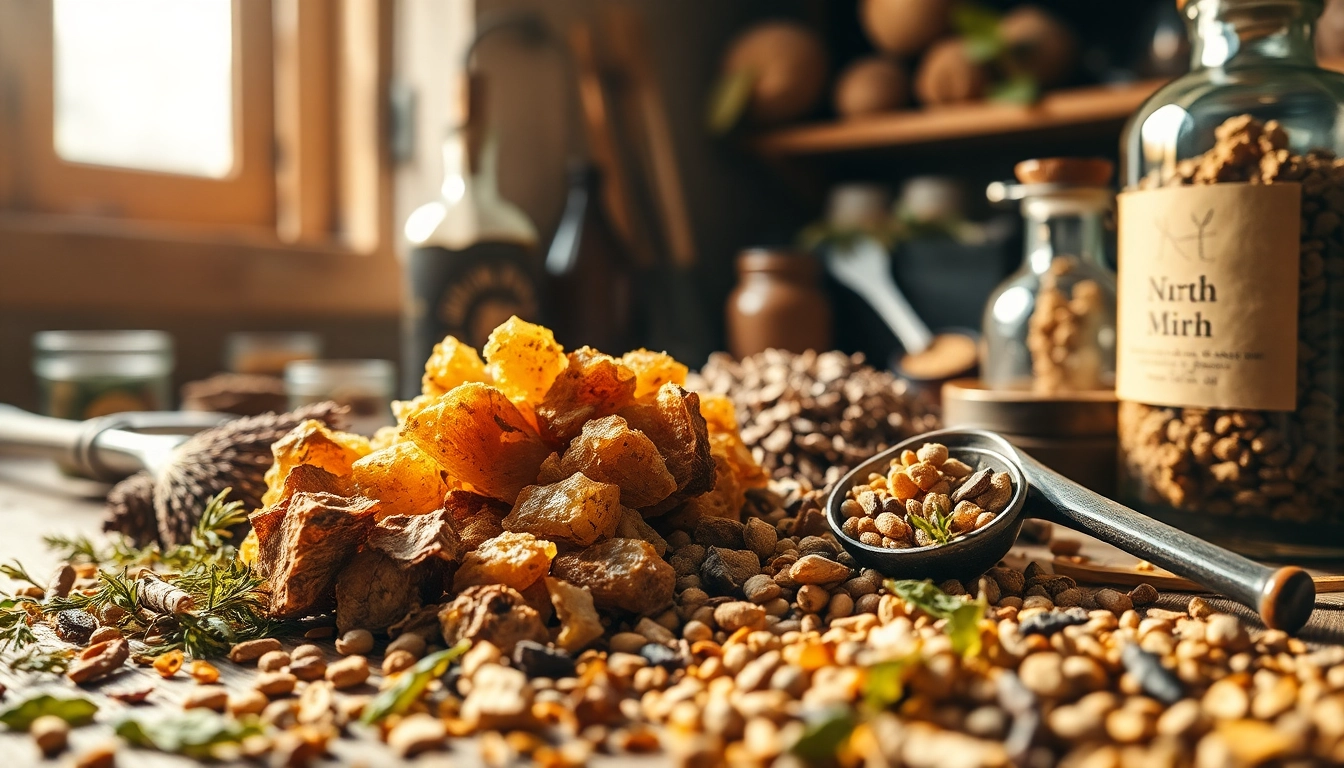1. Introduction to Myrrh
1.1 What is Myrrh?
Myrrh is a gum-resin exuded from the bark of several species of shrubs and small trees of the genus Commiphora. Traditionally harvested in regions such as the Arabian Peninsula and northeastern Africa, myrrh has been valued for its aromatic qualities and therapeutic properties. It appears as a yellowish-brown substance that hardens into lumps when it cools and is known for its warm, slightly bitter flavor. Historically, myrrh has played a significant role in various cultural practices, especially in religious and medicinal contexts.
1.2 Historical Significance of Myrrh
The use of myrrh dates back over 5,000 years. Ancient Egyptians used myrrh for embalming and in religious rituals, believing it helped to preserve the dead and drive away evil spirits. Myrrh was also one of the gifts brought to the Christ child by the Magi, symbolizing its esteemed value. Beyond its spiritual uses, it appeared in ancient medical texts and was employed by Greeks, Romans, and Chinese for its purported health benefits. The resonance of myrrh in history underscores its esteemed position across cultures, weaving a tapestry of significance that continues to captivate today.
1.3 Current Uses in Herbal Medicine
In modern herbal medicine, myrrh is often used for its anti-inflammatory and antimicrobial properties. It is typically incorporated into various preparations, from topical ointments to tinctures, targeting a variety of ailments including oral health issues, skin irritations, and digestive disorders. Practitioners sometimes recommend myrrh for its role in enhancing immunity and promoting the healing of wounds, demonstrating its enduring relevance in contemporary holistic health practices.
2. Health Benefits of Myrrh
2.1 Antimicrobial Properties of Myrrh
Research has shown that myrrh possesses strong antimicrobial properties that can inhibit the growth of various bacteria and fungi. This makes it a popular choice for natural remedies targeting infections. Studies have frequently highlighted its effectiveness against strains such as Staphylococcus aureus and Escherichia coli. Its ability to combat pathogens is linked to its rich variety of active compounds, including sesquiterpenes and essential oils, which function synergistically to promote health.
2.2 Myrrh for Digestive Health
An essential aspect of myrrh’s therapeutic application lies in its benefits for digestive health. Traditionally, myrrh has been used to alleviate digestive disorders, including indigestion, gas, and bloating. Its anti-inflammatory properties can soothe the lining of the digestive tract, while its potential to stimulate bile production aids in fat digestion. Furthermore, recent trends have explored myrrh’s role in maintaining gut microbiota, essential for optimal gut function.
2.3 Myrrh’s Role in Pain Management
Myrrh has efficacy in pain relief, particularly with joint and muscle pain. In herbal remedies, myrrh is often combined with other anti-inflammatory herbs for enhanced effects. Its ability to reduce swelling and increase blood circulation can be beneficial in managing conditions like arthritis and fibromyalgia. When applied externally in the form of oil or salve, myrrh provides localized pain relief, making it a powerful ally for those seeking to manage chronic pain.
3. Different Forms of Myrrh
3.1 Myrrh Resin: Harvesting and Uses
Myrrh resin is the most traditional form of this substance, obtained through a process that involves making incisions in the bark of Commiphora trees. Once the resin oozes out, it is collected and then allowed to harden. This method remains unchanged for centuries. Myrrh resin can be used in various forms, including incense, infusions, and salves in traditional medicine practices, highlighting its versatility. Users appreciate the authentic essence it brings to both health practices and spiritual rituals.
3.2 Essential Oil of Myrrh: Benefits and Application
The essential oil of myrrh, extracted through distillation of the resin, serves numerous therapeutic purposes. It’s commonly utilized in aromatherapy for its calming effects and is believed to enhance mental clarity. When diluted with a carrier oil, it can be applied topically for skin healing and oral health. The oil’s anti-inflammatory and antiseptic properties add additional layers to its applications, making it a popular choice in holistic health communities.
3.3 Myrrh in Supplements and Capsules
Myrrh is also available in the form of capsules and supplements, making it easier for individuals to incorporate it into their daily wellness regimens. These products often combine myrrh with other beneficial herbs, optimized for digestive health and immune support. It’s essential to choose high-quality supplements to ensure maximum efficacy. Consult with a healthcare provider to determine the appropriate dosing tailored to individual health needs and goals.
4. How to Use Myrrh Effectively
4.1 Traditional Methods of Myrrh Use
In traditional medicine, myrrh is most commonly used in the form of tinctures or infusions. To prepare a simple myrrh tincture at home, one can soak the resin in alcohol or vinegar for several weeks, shaking daily to ensure proper extraction. This preparation can be utilized in small dosages to promote healing. Additionally, myrrh can be burned as incense during meditative practices or rituals, offering a multi-sensory approach to its benefits.
4.2 Modern Applications of Myrrh in Wellness
Modern wellness practitioners have embraced myrrh in various forms, including skincare products, dietary supplements, and aromatherapy blends. Myrrh-infused creams can provide soothing relief for irritated skin, while incorporating it in massage oils combines its fragrant qualities with therapeutic benefits. Additionally, its inclusion in herbal teas and wellness shots capitalize on myrrh’s digestive health benefits, catering to the contemporary preference for functional foods.
4.3 Safety and Dosage Considerations for Myrrh
While generally considered safe for most individuals, myrrh should be used with caution, especially in those who are pregnant or nursing. Dosing can vary depending on the form used, and it’s crucial to follow product guidelines or consult a healthcare professional. Commonly recommended dosages range from 300 to 500 mg of resin per day for health applications, but individual needs may differ. Monitoring for potential allergic reactions or adverse effects is advisable, particularly in new users.
5. Myrrh’s Place in Current Herbal Trends
5.1 Myrrh in Aromatherapy
Aromatherapy has increasingly recognized myrrh’s rich aromatic profile. Its deep, resinous scent is valued in creating calming atmospheres; it is often blended with other essential oils to promote relaxation or spiritual grounding. Diffusers and personal inhalers are common ways to integrate myrrh into wellness routines, enhancing mental clarity and emotional balance. As interest in natural remedies grows, myrrh’s presence in the aromatherapy world is expected to expand further.
5.2 Myrrh in Skin Care Products
The skincare industry has remarkably adopted myrrh for its antibacterial and anti-inflammatory properties. Its inclusion in serums, moisturizers, and face masks targets acne and promotes skin healing. Myrrh oil works effectively in reducing scars and preventing further breakouts, making it a beloved ingredient in natural beauty products. As consumers continue to seek clean and sustainable beauty solutions, the demand for myrrh-infused products is anticipated to rise.
5.3 Cultural Relevance of Myrrh Today
Myrrh’s cultural relevance transcends its physical properties, resonating with spiritual and healing traditions around the world. In many cultures, it represents purification and protection. Its historical background enriches its narrative today, giving individuals who appreciate natural remedies a way to connect with practices of the past. Myrrh continues to inspire new generations eager to explore holistic health, bridging the gap between ancient wisdom and modern wellness approaches.


